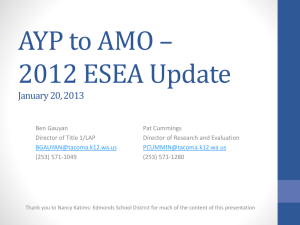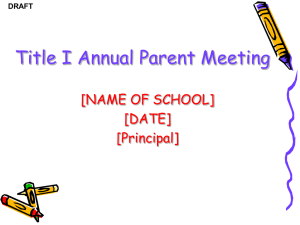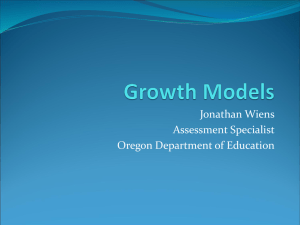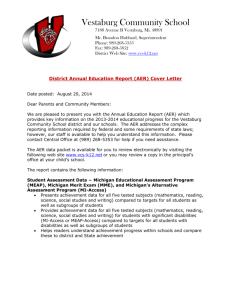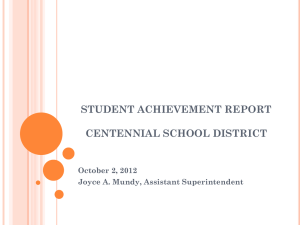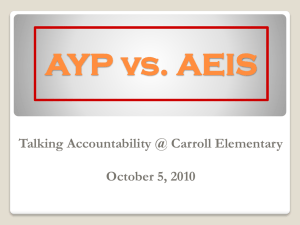District Level AYP Model: Original and Revised (Split Grade Spans
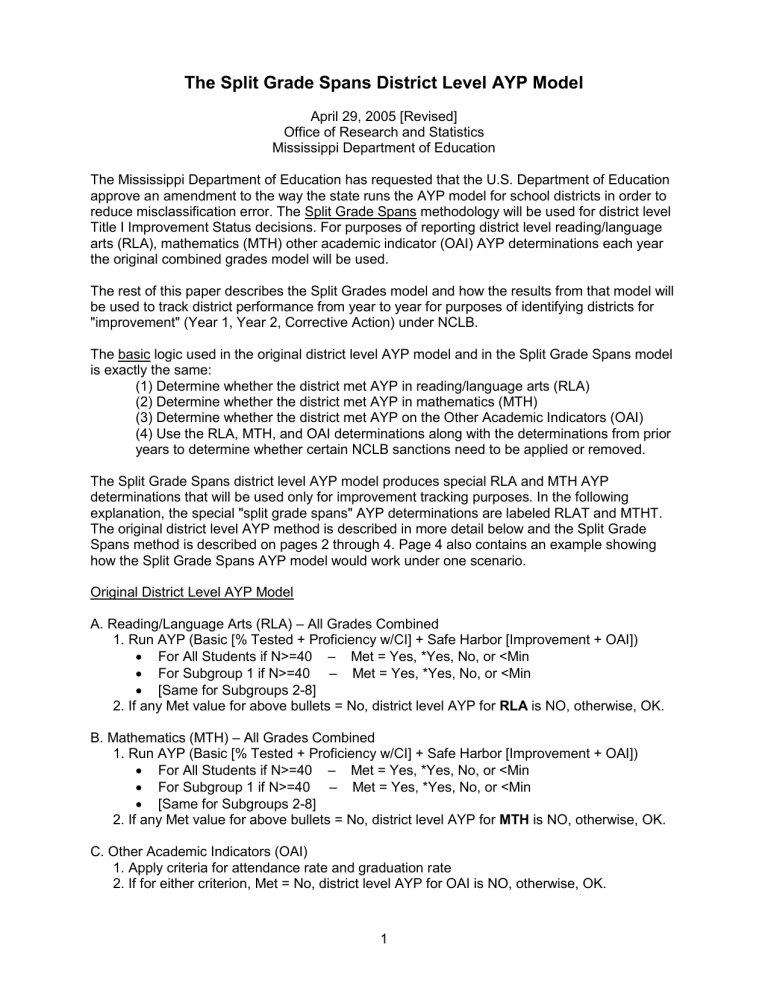
The Split Grade Spans District Level AYP Model
April 29, 2005 [Revised]
Office of Research and Statistics
Mississippi Department of Education
The Mississippi Department of Education has requested that the U.S. Department of Education approve an amendment to the way the state runs the AYP model for school districts in order to reduce misclassification error. The Split Grade Spans methodology will be used for district level
Title I Improvement Status decisions. For purposes of reporting district level reading/language arts (RLA), mathematics (MTH) other academic indicator (OAI) AYP determinations each year the original combined grades model will be used.
The rest of this paper describes the Split Grades model and how the results from that model will be used to track district performance from year to year for purposes of identifying districts for
"improvement" (Year 1, Year 2, Corrective Action) under NCLB.
The basic logic used in the original district level AYP model and in the Split Grade Spans model is exactly the same:
(1) Determine whether the district met AYP in reading/language arts (RLA)
(2) Determine whether the district met AYP in mathematics (MTH)
(3) Determine whether the district met AYP on the Other Academic Indicators (OAI)
(4) Use the RLA, MTH, and OAI determinations along with the determinations from prior years to determine whether certain NCLB sanctions need to be applied or removed.
The Split Grade Spans district level AYP model produces special RLA and MTH AYP determinations that will be used only for improvement tracking purposes. In the following explanation, the special "split grade spans" AYP determinations are labeled RLAT and MTHT.
The original district level AYP method is described in more detail below and the Split Grade
Spans method is described on pages 2 through 4. Page 4 also contains an example showing how the Split Grade Spans AYP model would work under one scenario.
Original District Level AYP Model
A. Reading/Language Arts (RLA) – All Grades Combined
1. Run AYP (Basic [% Tested + Proficiency w/CI] + Safe Harbor [Improvement + OAI])
For All Students if N>=40 – Met = Yes, *Yes, No, or <Min
For Subgroup 1 if N>=40 – Met = Yes, *Yes, No, or <Min
[Same for Subgroups 2-8]
2. If any Met value for above bullets = No, district level AYP for RLA is NO, otherwise, OK.
B. Mathematics (MTH) – All Grades Combined
1. Run AYP (Basic [% Tested + Proficiency w/CI] + Safe Harbor [Improvement + OAI])
For All Students if N>=40 – Met = Yes, *Yes, No, or <Min
For Subgroup 1 if N>=40 – Met = Yes, *Yes, No, or <Min
[Same for Subgroups 2-8]
2. If any Met value for above bullets = No, district level AYP for MTH is NO, otherwise, OK.
C. Other Academic Indicators (OAI)
1. Apply criteria for attendance rate and graduation rate
2. If for either criterion, Met = No, district level AYP for OAI is NO, otherwise, OK.
1
Split Grade Spans District Level AYP Model
A
E
. Reading/Language Arts (RLA) – Elementary Grades (3-5) Data Only
1. Run AYP (Basic [% Tested + Proficiency w/CI] + Safe Harbor [Improvement + OAI])
For All Students if N>=40 – Met = Yes, *Yes, No, or <Min
For Subgroup 1 if N>=40 – Met = Yes, *Yes, No, or <Min
[Same for Subgroups 2-8]
2. If any Met value for above bullets = No, RLAT Elementary Level is NO, otherwise, OK.
A
M
. Reading/Language Arts (RLA) – Middle Grades (6-8 1 ) Data Only
1. Run AYP (Basic [% Tested + Proficiency w/CI] + Safe Harbor [Improvement + OAI])
For All Students if N>=40 – Met = Yes, *Yes, No, or <Min
For Subgroup 1 if N>=40 – Met = Yes, *Yes, No, or <Min
[Same for Subgroups 2-8]
2. If any Met value for above bullets = No, RLAT Middle Level is NO, otherwise, OK.
A
H
. Reading/Language Arts (RLA) – High School (English II MC 1 ) Data Only
1. Run AYP (Basic [% Tested + Proficiency w/CI] + Safe Harbor [Improvement + OAI])
For All Students if N>=40 – Met = Yes, *Yes, No, or <Min
For Subgroup 1 if N>=40 – Met = Yes, *Yes, No, or <Min
[Same for Subgroups 2-8]
2. If any Met value for above bullets = No, RLAT High School Level is NO, otherwise, OK.
A
X
. Use the grade span RLAT decisions to make a district level RLAT AYP determination.
If more than 2 grade span decisions = No, district level RLAT is NO otherwise, OK.
1 Note: NCLB specifies three grade spans – 3-5, 6-9, and 10-12. For RLA, Mississippi's approved AYP plan uses MCT reading and language data at grades 3-8 and English II data
(used when and at the grade and district/school at which student took the course & test). NCLB does not require assessment at Grade 9.
(Split Grade Spans Model continues on the next page)
2
Split Grade Spans District Level AYP Model (continued)
B
E
. Mathematics (MTH)
–
Elementary Grades (3-5) Data Only
1. Run AYP (Basic [% Tested + Proficiency w/CI] + Safe Harbor [Improvement + OAI])
For All Students if N>=40 – Met = Yes, *Yes, No, or <Min
For Subgroup 1 if N>=40 – Met = Yes, *Yes, No, or <Min
[Same for Subgroups 2-8]
2. If any Met value for above bullets = No, MTHT Elementary Level is NO, otherwise, OK.
B
M
. Mathematics (MTH) – Middle Grades (6-8 1 ) Data Only
1. Run AYP (Basic [% Tested + Proficiency w/CI] + Safe Harbor [Improvement + OAI])
For All Students if N>=40 – Met = Yes, *Yes, No, or <Min
For Subgroup 1 if N>=40 – Met = Yes, *Yes, No, or <Min
[Same for Subgroups 2-8]
2. If any Met value for above bullets = No, MTHT Middle Level is NO, otherwise, OK.
B
H
. Mathematics (MTH) – High School (Algebra I 1 ) Data Only
1. Run AYP (Basic [% Tested + Proficiency w/CI] + Safe Harbor [Improvement + OAI])
For All Students if N>=40 – Met = Yes, *Yes, No, or <Min
For Subgroup 1 if N>=40 – Met = Yes, *Yes, No, or <Min
[Same for Subgroups 2-8]
2. If any Met value for above bullets = No, MTHT High School Level is NO, otherwise, OK.
B
X
. Use the grade span MTH decisions to make a district level MTH AYP determination.
If more than 2 grade span decisions = No, district level MTHT is NO otherwise, OK.
1 Note: NCLB specifies three grade spans – 3-5, 6-9, and 10-12. For MTH, Mississippi's approved AYP plan uses MCT mathematics data at grades 3-8 and Algebra I data (used when the student is in grade 10 regardless of grade and district/school at which student took the course & test). NCLB does not require assessment at Grade 9.
(Split Grade Spans Model continues on the next page)
3
Split Grade Spans District Level AYP Model (continued)
C
E/M
. Other Academic Indicator
–
Elementary/Middle (Attendance Rate) Data Only
If district does not meet OAI criterion, OAIT Elementary/Middle is NO, otherwise, OK.
C
H
. Other Academic Indicator – High School (Graduation Rate) Data Only
If district does not meet OAI criterion, OAIT Elementary/Middle is NO, otherwise, OK.
Note: The above are applied only for "All Students," not for separate AYP subgroups.
C
X
. Use the grade span OAI decisions to make a district level OAI AYP determination.
If both grade span decisions = No, district level OAIT is NO otherwise, OK.
D. Use the district level RLAT , MTHT , and OAIT AYP determinations along with determinations from prior years to make decisions regarding NCLB sanctions.
These are the district level RLAT, MTHT, and
OAIT decisions based on the split grade spans methodology (i.e., from steps A, B, and C shown on the last three pages).
Example of the Split Grade Spans Model
RLAT Elementary Grade Results
All Students
SPED Students
Black Students
White Students
Met = Yes Elementary
Met = Yes Decision is OK
Met = Yes 0 "No"s
Met = Yes
RLAT Middle Grade Results
All Students
SPED Students
Black Students
White Students
Met = Yes Middle
Met = No Decision is No
Met = Yes
Met = Yes
RLAT High School Grade Results
At least 1 "No"
District Level Determination:
RLAT = Yes
(2 "No"s are allowed)
All Students
SPED Students
Black Students
White Students
Met = Yes High School
Met = No Decision is No
Met = No At least 1 "No"
Met = No
The same logic would be applied to the three grade spans in mathematics to get a district level
MTHT determination.
4
STATE RESPONSE AND STATE ACTIVITIES FOR MEETING REQUIREMENTS
The method used for determining whether each student subgroup, each public school, and each district/LEA makes AYP is stated below and is illustrated (for reading/language arts and mathematics) on the flowchart on the next page.
For a public school and LEA to make adequate yearly progress in reading/language arts or in mathematics, each student subgroup must meet or exceed the State annual measurable objectives and each student subgroup must have at least a 95% participation rate in the statewide assessments. However, if in any particular year the student subgroup does not meet those annual measurable objectives, the public school or LEA makes AYP, if the percentage of students in that group who did not meet or exceed the proficient level of academic achievement on the State assessments for that year decreased by 10% of that percentage from the preceding public school year; that group made progress on one or more of t he State’s academic indicators; and that group had at least 95% participation rate on the statewide assessment.
In order to meet AYP on the other academic indicator(s), the school or LEA must meet the State’s criteria for other academic indicators.
The sequence of steps used in determining AYP is important. The sequence, shown clearly on the flowchart (for steps 1-4), follows.
1. Calculate the n-count for the subgroup (or aggregate group, as appropriate) and compare the value to the minimum n criterion (see 5.5). If the n-count is smaller than the minimum n criterion, the subgroup is not used in determining AYP.
Note: A subgroup with an n-count too small to count toward AYP at the school level may be large enough to count toward AYP at the district/LEA and/or state levels.
2. Calculate the assessment participation rate value for the subgroup [or student aggregate] (see
10.1 and 10.2). If the participation rate does not meet the criterion of 95%, in reading/language arts or in mathematics, the subgroup did not make AYP in that subject area.
3. If the participation rate is at least 95%, apply the appropriate confidence interval to the subgroup's proficiency percentage to determine whether the subgroup met the annual measurable objectives .
4. If the subgroup did not make AYP under the criteria in step 3, apply the test to determine whether AYP was met under the alternative method (sometimes called "safe harbor".
5. Apply test against additional academic indicator(s) for the aggregate (not the subgroups).
The determination of AYP will be made annually for each public school and each district/LEA in three areas – reading/language arts, mathematics, and other academic indicators. The AYP determinations from steps 1-5 above will be reported annually in the NCLB Report Cards.
School Improvement. Failure to make AYP over consecutive years -- defined as failure of ANY subgroup or the student aggregate failing to make AYP in the same content area (reading/language or mathematics) or the student aggregate failing to make progress on the other academic indicator(s) – will result in a Title I school being identified for improvement, corrective action, or restructuring as specified in NCLB. For a school to exit from improvement status, it must meet
AYP for two consecutive years in the area(s) that triggered improvement.
LEA Improvement. For LEAs, Title I improvement status will be determined by tracking annual results on the "split grade spans" model. For reading/language arts and mathematics, separate proficiency indexes are calculated for each grade span (3-5, 6-9, 10-12). The LEA meets the subject area criterion if all subgroups meet the criterion in at least one of the grade spans. For other academic indicators, the LEA meets the criterion if either the attendance rate criterion
(elementary/middle) or the graduation rate criterion (high school) is met. An LEA that fails to meet the criterion in any area (reading/language, mathematics, or other academic indicators) for two consecutive years will be identified for improvement. For an LEA to exit from improvement status, it must meet the "split grade spans" criteria above for two consecutive years in the area(s) that triggered improvement.
5
